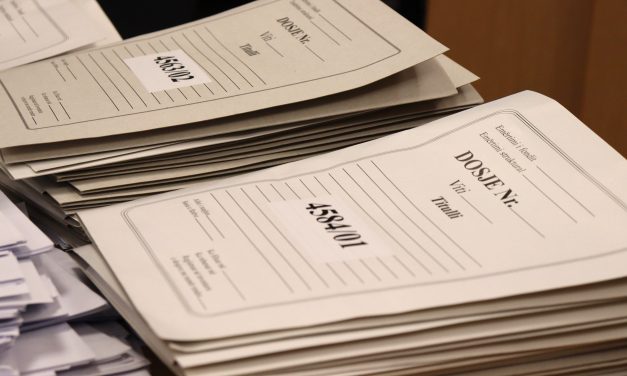The State Election Commissioner, Mr. Ilirjan Celibashi and Deputy Commissioner Mrs. Lealba Pelinku visited today the CEC premises in Lunder, where dactyloscopic traces of the voters are being checked and verified in electronic identification devices returned from the voting centers.
During a media statement, Commissioner Celibashi reported that currently, the data are being transferred to the main server of the Central Elections Commission.
Celibashi said “This is the first stage in the entire process of verification of the data obtained from voters’ identification process. At the end of the first stage, copying the data in the main server, we will cross check the data in all devices used in the Voting Centers. Through the process of cross checking of the data, we will see if there are cases when voting took place in several different voting centers, or within the same voting center”.
After the publication of a video in the social media, Celibashi stated that he and Deputy Commissioner Pelinku have explained that the purpose of using this device was to record the finger prints of those who would go to the polls.
“Those individuals, who, for different reasons wanted to test the device or for illegal reasons put the finger several time on the device or in different devices, will be clearly identified and will be held accountable to the competent bodies. Those who claim that the device was not working, – my reply to them is that the device was working and the purpose was to identify the finger prints which the voters leave during the voting process” Celibashi stated.
The Commissioner confirmed that if a voter placed the finger more than once on the identification device, he should give an explanation on the circumstances how this happened. The greater the number of videos posted on social networks, the more they contribute to the process of investigation and verification.
Deputy Commissioner Lealba Pelinku stated that all the findings that will result by cross checking of the data, will be sent to the Prosecutor’s Office and the Court will decide whether the Electoral Code has been violated by the operator or the voter.
“The cross checking of the data needs time as we should consider the fact that one finger print will be checked with 1.6 million finger prints to verify whether there was a duplication”.
Asked by the reporters whether the cross checking of the data and QR code in the ballot paper could identify the vote of a citizen, Celibashi categorically dismissed it as impossible.
“Absolutely not possible, for two reasons : first, the voters electronic identification device does not record the order of the voters; the report generated by the device on the voters does not rank the voters according to the order of the voting. There is no ranking, it is a random listing of them in the report and secondly, the choice of the ballot for a voter is also a random one. The ballot papers are not taken in stubs and according to the order of the stubs. Nobody knows the number in each stub. In the same way, at the moment a voter takes the ballot paper, and other four of five ballot papers might be also there, sealed in advance by the VCC, it is impossible for anyone, even for the Commissioner to identify which ballot was given to whom”.
The process of verification, based on the Electoral Code is carried out after the election day and after the announcement of election results. The information received after cross checking of the data in PEI devices will be used for investigation purposes and to impose further sanctions in cases of violations of the law.
